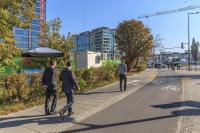The green face of concrete
Remarkable concrete surface with pollution-absorbing properties was laid at Rondo Daszyńskiego, a junction in Warsaw and the location of the Generation Park office park; it is a product of joint efforts of Skanska and Górażdże Cement S.A. with scientific support from the Warsaw University of Technology Faculty of Civil Engineering and others.
The innovation in this technology is based on the photocatalytic characteristics. In sunlight, the special mix of ingredients used can act to reduce nitrogen oxide levels from car exhaust fumes, which have a particularly negative impact on the pulmonary system. Harmful pollutants are broken down into health-neutral compounds on the concrete surface. On top of that, this new concrete formula boasts self-cleaning, antibacterial and antifungal properties.
Such characteristics makes the product an invaluable aid in the fight against smog caused by exhaust emissions. And it is directly linked with the increased traffic at major thoroughfares. For this reason, Skanska and Górażdże planned to locate the test section at the busy junction of Rondo Daszyńskiego in Warsaw. Pavement with a surface area of 350 sq. m was built for testing purposes. Positive results encouraged an incorporation of a pitch-size square made of the “green” concrete between the Generation Park office buildings in the final project. Now, the concrete helps bring down nitrogen dioxide levels by 30%. There is a chance to drive this performance further up once the surrounding area is fully developed; laboratory testing has shown a reduction rate of approx. 70%.
“Socially responsible business means also care about the surroundings and the environment in which we develop. We are complementing Skanska’s famous array of “green” technologies with advanced materials technologies to make our lives better in a cleaner and friendlier environment. Concrete has been known as a building material for thousands of years and, apparently, it can also work to improve the quality of air we breathe by reducing harmful gases which make up smog. The first large-scale application of this concrete type in a development project located in Central and Eastern Europe is now made in our Generation Park scheme in Warsaw,” says Rafał Stoparczyk, Project Manager at Skanska office company.
Two members of the academic staff of the Warsaw University of Technology Faculty of Civil Engineering have contributed to this solution. Under a joint implementation project, Wioletta Jackiewicz-Rek, Ph.D. Eng., Dean’s Proxy for Studies, and Karol Chilmon, M.Sc. Eng., have been part of the preparatory work for the implementation concept and a number of accompanying activities. These included, e.g., preparing materials for microscope testing to assess the health impact of the technology; research into the impact of the use of such paving stones on pollution reduction efficiency and an analysis of the results of airborne NOx reduction efficiency testing.








